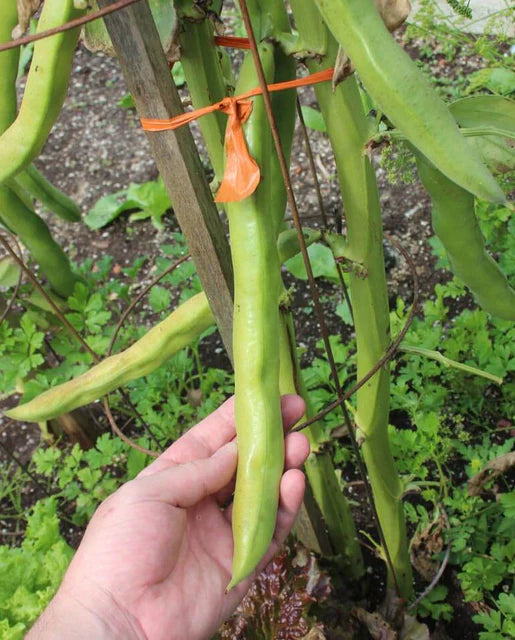272 products
272 products
Sort by:
West Coast Seeds
Aji is a standard pepper throughout South America. One of the reasons it is not well known here is its slow growth and heat demands. Aji Rico really shows the best of what can be achieved through hybrid plant breeding. Compared to many of the open pollinated heirloom peppers, it boasts faster maturity, better vigour, and higher yields. The tasty pods are medium hot, maturing to full size as green chilies in 50-55 days. Add another twenty days for mature red pods, and the sweet, full-bodied flavour that comes with them. The fruits average 8-10cm (3-4") long, with thin walls and a conical shape. The plants are large in stature at 76-91cm (30-36") tall, so they benefit from staking or a trellis. These AAS Award winning peppers retain their floral, citrus flavour in cooking, and the heat level can be reduced by removing the seeds and pith. 500-1,000 SHUs
Matures in 75 days. (Hybrid seeds)
Gorgeous jalapeno-shaped peppers mature from bright green to nearly jet black, and finally to intense scarlet red. The productive 60cm (24") tall plants are loaded with fruits of medium heat. Use these interchangeably with jalapeno peppers for a a dash of drama in dips and salsas. The flavour really brightens as they mature, and the colour stands out on market tables. Try Black Hungarian pepper seeds in patio containers but aim to keep the soil constantly moist during the growing season and allow for good air circulation around plants. Mildly spicy 1,000-2,5000 SHUs.
Matures in 70 days. (Open-pollinated seeds)
Ghost Chili seeds are also known as the Bhut Jalokia. At over one million Scoville Heat Units, the Ghost Chili is one of the world's hottest peppers. This pepper is so hot, in fact, that it should be treated with caution. We encourage very careful handling of the seeds and fruits. Use gloves when handling the fruits and be extremely careful not to bring the peppers or their residue in contact with eyes or mucous membranes. The pepper is said to be 400 times hotter than Tabasco Sauce, and easily three times hotter than our sweat inducing Red Habanero. This is a slow growing plant that produces fruits at the end of the growing season. If it can be kept going over winter, it can be grown as a perennial, producing much larger yields in the second year of growth. 1,000,000+ SHUs
Super-hot peppers are tricky to grow. The seeds are difficult to germinate under home growing conditions and they need a long, hot season to produce fruit. To mature in most regions, protection is needed to increase heat and lengthen the growing season.
Matures in 100 days. (Open-pollinated seeds).
Habanero pepper seeds are central to the cuisine of Yucatan, Mexico. The little lime-green peppers ripen first to sunset golden, and then to "You've been warned" red. Mature 5cm (2") habaneros have a citrusy flavour and aroma. The seed is slower to germinate (up to 3 weeks) and should be kept at 21-24°C (70-75°F). Use bottom heat of a Seedling Warmer heat mat to accelerate germination. Plants need fertile soil and lots of heat to mature but are well worth the time - and the tears. For most regions in Canada, providing protection to increase heat and lengthen the growing season is necessary for success. At 100,000 - 350,000 SHU's, these powerful chiles are for spice lovers, and not for the faint of heart. Can be grown in containers.
Matures in 100 days. (Open-pollinated seeds)
Jalapeno M Pepper Seeds produce pungent, thick-walled and juicy dark green peppers that are 8cm (3") long and about 2cm (1") wide with a blunt end. Fruits set well on mid-sized plants 60-90cm (24-36") tall. If there are still green peppers on the plant at the end of the season, pull up the whole plant and hang in a dry spot for it to finish ripening to red. Use green peppers for fresh eating, pickling, and sauces, and dry the red ones. 2,000 - 5,000 SHU's. Jalapeno M works well in 3–5-gallon containers and is suitable for patio growing. Dried, smoked jalapenos are known as chipotle peppers.
Matures in 70 days. (Open-pollinated seeds)
Early maturity and large, attractive fruit make Arapaho an excellent Cayenne pepper. Compact, 45cm (18") tall plants produce high yields of 20-22cm (8-9") long fruit with moderately thick walls and mild heat. The peppers dry well for making homemade hot chile powder, and they're the perfect size for creating decorative ristras. 2,000-4,000 SHUs.
Matures in 70 days. (Hybrid seeds)
This is the classic large overwintering onion of the Pacific Northwest. A very large, juicy onion with a mild sweet flavour. It can be planted in the spring if given a really early start indoors, or in August to overwinter. Spring planted Walla Walla sweet onion seeds result in bulbs that are not quite as mild as the overwintered ones and may not size up as well. Plants can also be harvested as a delicious, sweet bunching onion.This variety is hardy to -23°C (-10°F). It is most definitely a long day onion, suitable for planting between the 35th and 55th parallels. It might not have good storage ability, but it makes beautiful, caramelized onions!
Matures in 125 days, spring sown - 300 days fall sown. (Open-pollinated seeds)
Personal size mini melon with a wonderfully sweet flavour. Tasty Bites’ .5kg (1#) fruit have light yellow netted skin and deep orange flesh, developed by crossing an ananas and a Charentais. Vigorous plants with good disease resistance produce high yields of these tasty treats. Fruit ripens over a long period making this a good choice for gardeners and market growers.
Matures in 75-80 days
Exposure Full Sun
A seed tape version of this flavourful tipburn resistant (TBR) variety. Grand Rapids TBR Looseleaf lettuce seeds produce a large, upright rosette of thick, juicy, light-green, frilly leaves and a blanched centre. The variety features very rapid growth in spring and fall, and grows better than any other variety under cool, damp, low-light conditions. Try Grand Rapids TBR in cold frames or beneath a cloche greenhouse for salad production all winter. In the spring and summer, sow short rows often so the crop can be harvested over a long period, and so that you are not overwhelmed by a garden full of mature lettuce all at once.
1 pack includes 2 x 2.5m (6.5') of tape and contains approximately 350 seeds in total.
Start by making shallow rows in prepared soil. Unfold tape and separate the two strips. Place tape in the rows and water. Cover with 5mm (0.25 inch) of soil. Water well. Keep consistent moisture until seeds sprout in 7-15 days.
Matures in 65 days. (Open-pollinated seeds)
Our earliest red cabbage that performs well spring to fall. Ruby Ball Improved’s 1-1.4kg (2-3lb) dense purple heads hold well for a flexible harvest. Its small size means it is perfect for close spacing in the garden and dense plantings in the field. Add a late planting of Ruby Perfection to extend the season into late fall.
Matures in 72 days
Exposure Full Sun
Dark green, pie-shaped scallopini squash with pure white flesh and superior flavour at immature or full-grown size. Plants are upright and open, so the fruits are easy to see and pick. Total Eclipse pattypan squash seeds replaces Starship as a dark green scallopini. Our favourite use is picking them shortly after pollination, when the fruits are still tiny at only 5cm (2") across. At this stage they are incredibly tender and delicate, and they make a stunning side dish for any meal. Total Eclipse's hybrid vigour means that the plants are very productive and the squash are nice and uniform.
Matures in 45 days. (Hybrid seeds)
- Easy to digest
- Super-food
- Amazing colour
- Rich in nutrients
- Ready to harvest in 3 weeks
Microgreen beet seeds have a mild, spinach-like flavour. Intensely purple stems and bright green leaves that are even more nutrient-dense than mature beets! Try them as a replacement for baby spinach in salads, or simply as an eye-catching garnish. Beet seeds are a little larger than some of the other microgreens. Be sure to push each seed gently into the soil, or sprinkle enough seed starting mix over the seeds to just bury the seeds and tamp down to lightly compress. Keep the soil moist until germination by regularly misting. The beet microgreens will be ready to harvest around 20 days from planting.
- Mild-spinach like flavour
- Intensely purple stems and bright green leaves
- Try them as a replacement for baby spinach in salads
- Makes a great garnish
- Very quick production
CERTIFIED ORGANIC! Hard red wheat, barley, oats, and triticale are some of the fastest growing sprouts. They are ready to eat just as the root tip emerges. Keep the red skins intact for the highest nutrition. This blend supplies vitamins A, B, C, and E, as well as calcium, iron, niacin, magnesium, potassium, manganese, fibre, and protein.
- Fast growing
- Nutrient dense
- Good for juicing
- Certified Organic
These wonderful large beans mature in 75-85 days when sown in the spring, or 6 months if fall sown. The plants grow 90-120cm (3-4') tall. The light green pods, which contain 6-7 large pale green seeds each, shell easily. Windsor broad bean seeds are superb for family gardens and easy for small children to handle. Broad Windsor is intended for growing as a food crop. The seeds it produces are large and succulent, unlike the small-seeded fava we offer as a cover crop. This large variety will fix nitrogen in your soil, so it’s perfect for planting in the fall, harvesting in the spring, and following with nitrogen loving crops like Brassicas, lettuce, or spinach. Fresh or dried, broad beans must be cooked before eating in order to rid them of potentially toxic alkaloids. The young, tender leaves can be eaten raw, or cooked like spinach. Broad beans are one of the world’s most ancient and widespread food crops.
Matures in 75-85 days. (Open-pollinated seeds)















